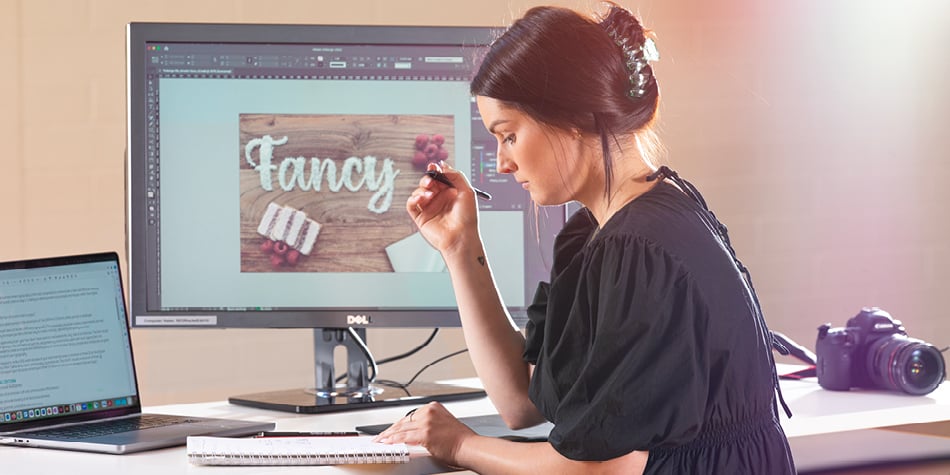Creative problem solving, driving innovation and engaging with empathy are just some of the skills that Deakin design graduates acquire through their design thinking practice.
We spoke to Dr Russell Kennedy, Head of Art and Design at Deakin’s School of Communication and Creative Arts, about the far-reaching impact and influence of design thinking and how Deakin students are embracing it.
Exploring big and small questions
‘Design thinking is a solution-driven process. It identifies and understands human-centred business and societal problems. It develops innovative solutions based on research and testing,’ says Dr Russell Kennedy.
‘It’s an evolutionary process that pushes ideas forward with deep understanding of what the consumer needs. There was a time when designers were brought into the process after the strategy and design brief had been established. Now, successful businesses using design thinking strategies and include designers in their research in a collaborative approach from the get-go.’
Design is also a growth industry. Design professionals are in high demand, with roles projected to increase by 2026 according to Australian Government employment projections. This includes 13,900 new jobs for Communication Designers (graphic, UX and web designers, and illustrators).
Design is part of Deakin's DNA
Design thinking is embedded into Deakin’s design courses. From your first year through to your last, you’ll work on team related projects with industry collaboration to combine best-practice global research for practice-based outcomes. For example, students recently engaged with staff at Pedigree Paper, a print company, working on a real life brief for their rebrand.
Deakin teaches the Stanford University, d. school model of design thinking, which is widely accepted as a powerful tool adopted by businesses and organisations to solve complex problems. It consists of five steps – building empathy to understand the consumer, defining the problems, ideating and exploring possibilities, making a prototype and testing. The testing process keeps businesses from investing time and money into solutions that don’t work.
Acquiring invaluable tools and skills
At Deakin you’ll learn to use tools essential to the design thinking process, like journey mapping, persona and empathy maps, storytelling and visualisation. You’ll be taught strategies and methodologies that will enable you to be an adaptable, agile, multidisciplinary designer – like how to utilise cutting-edge technology and the creative practices of design to create memorable work. You’ll also study businesses that have successfully adopted design thinking strategies, such as Apple, IBM, Netflix and more.
As Abbey Blake, a Bachelor of Design (Visual Communication) 2022 graduate reflects, ‘Our design thinking and ideation methods were pushed and tested to ensure we produced unique and engaging concepts that could solve future design problems.’
Gaining real-world, practical experience is essential to build the necessary skills to be job ready. Studying design at Deakin means you’ll work from real-life briefs to progress your skills.
Abbey explains, ‘this course has a very strong focus on preparing us to work in the industry when we graduate. In second year, and especially in our third year, we have been expected to submit our work to the industry standards to ensure we can understand professional practice in design.’
Design thinking is multi-faceted and omnipresent
Deakin encourages students from all areas to take design thinking related electives, from architecture to business and law, in recognition of the vast and varied opportunities in this field.
You can study design thinking at an undergraduate level through to research. Deakin has pioneered several successful research projects in the design thinking area – notably when Dr Russell Kennedy was invited by the NASA-aligned, ISS National Laboratory and the World Design Organisation (WDO) to imagine a new future for the International Space Station.
Since 2020 he has been working on a concept for an orbital university based out of the International Space Station. He is investigating how to connect students on earth to the ISS, for them to feel like they're studying in space. He has used design thinking to aid this process.
‘Design can contribute to the orbital university on many levels. Problem solving and ideation exploration through the design thinking process is our starting point.’ Dr Kennedy says, ‘proving that design thinking is literally used everywhere!’
Build a sustainable, design-focussed career
A recent American study shows the use of design thinking has risen across a range of industries since 2015. It’s grown 140% in manufacturing, 86% by finance and insurance, and a staggering 250% in human health*.
‘There are now open-ended opportunities for graduates. Design thinking is a future-proof area.’ Dr Kennedy explains, ‘it promotes innovation and pushes businesses forward ahead of their competitors, which is why companies like PWC, KPMG and Deloitte have now embraced it.’
‘Our graduates work across all industry sectors, including digital and publishing, advertising, corporate companies and NGO’s. Others are self-starters and are pursuing entrepreneurial opportunities.’
Design can drive business through innovation, as well as facilitate positive change in society.
Interested in studying design? Take a look at Deakin design courses on offer.
Footnotes
*https://www.innovationtraining.org/design-thinking-2022-study-from-hpi/

